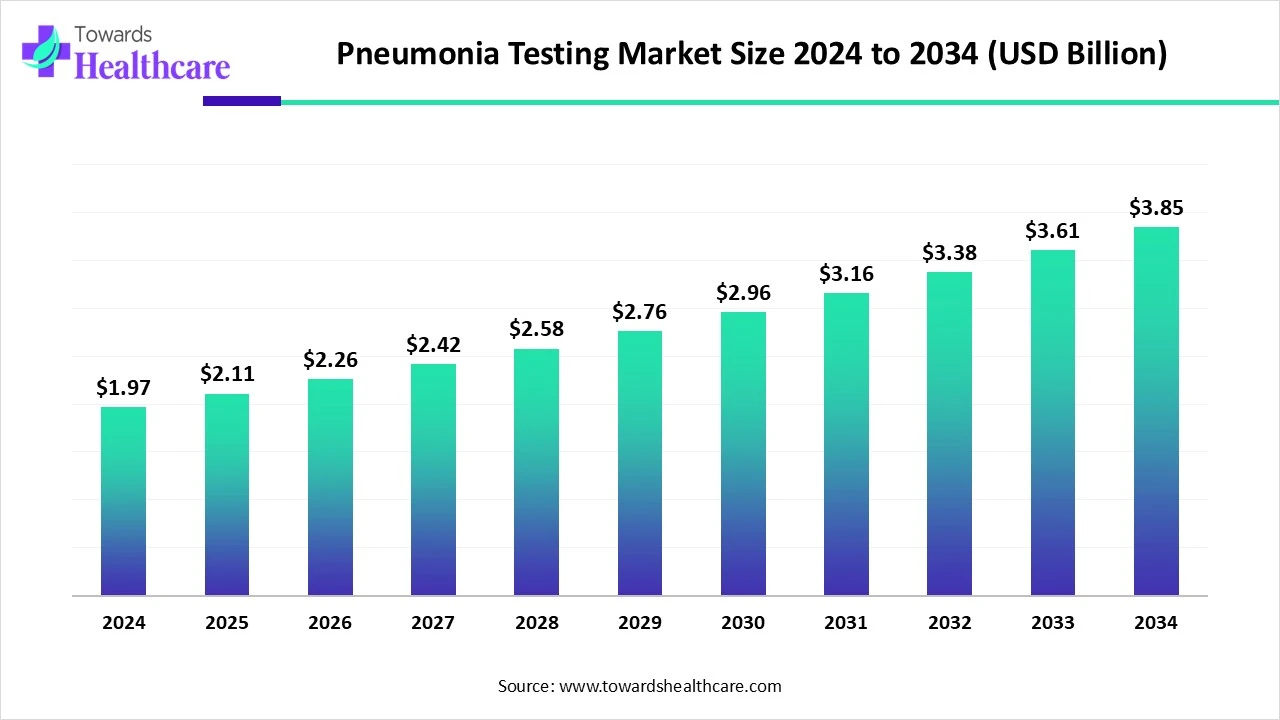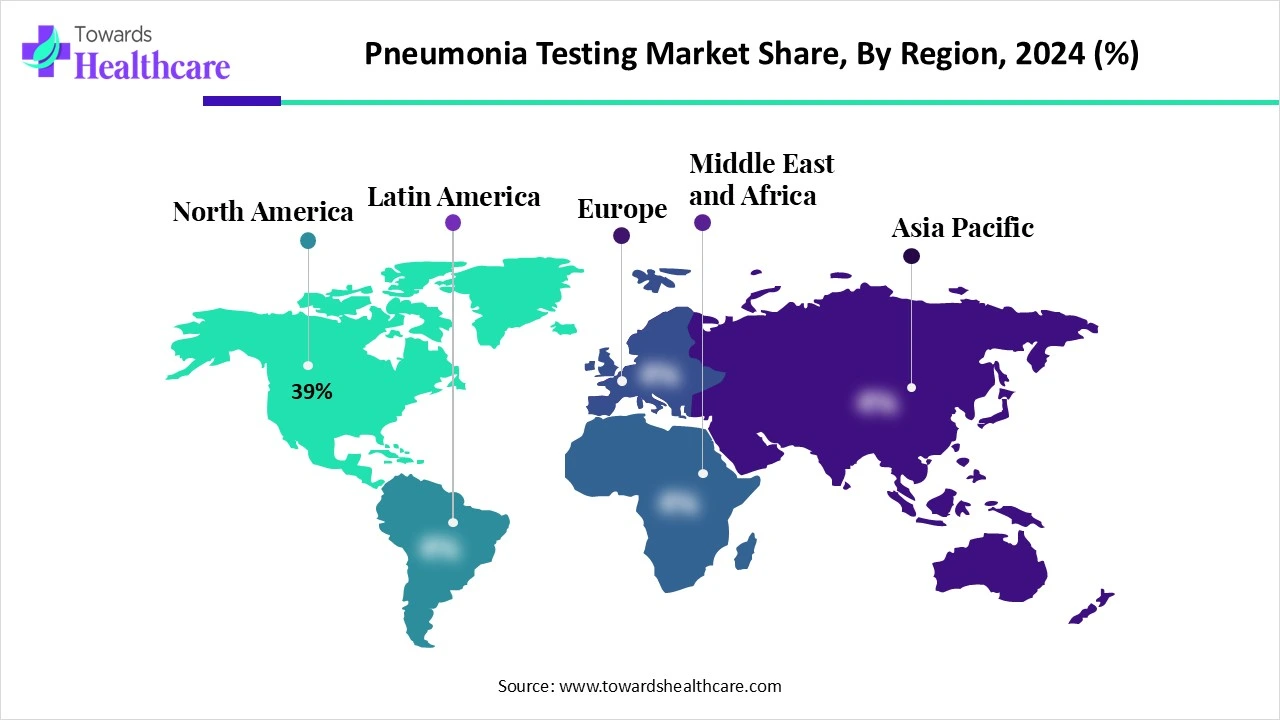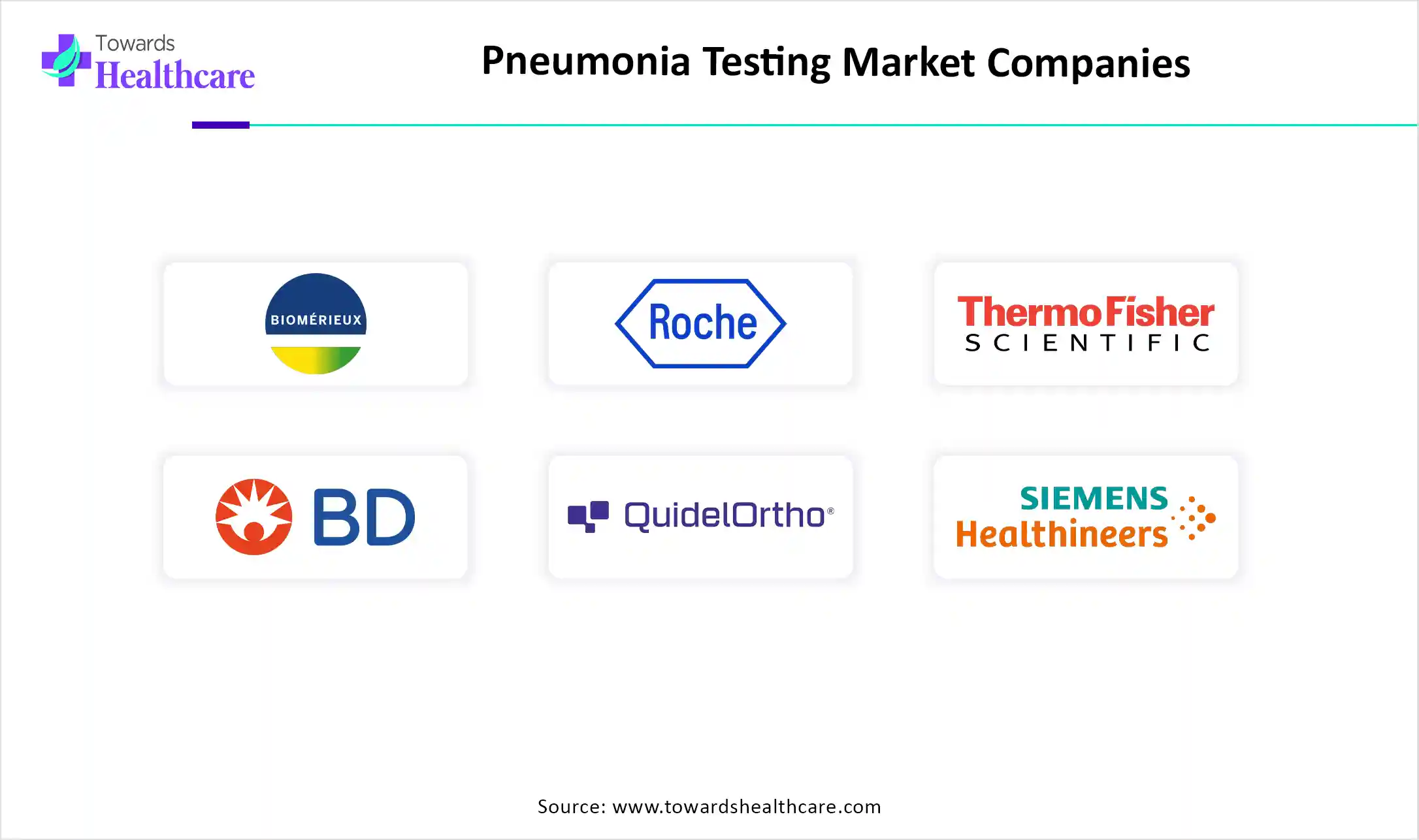December 2025

The global pneumonia testing market size is calculated at USD 1.97 billion in 2024, grew to USD 2.11 billion in 2025, and is projected to reach around USD 3.85 billion by 2034. The market is expanding at a CAGR of 6.97% between 2025 and 2034.

The pneumonia testing market is primarily driven by the rising prevalence of pneumonia and the growing research and development activities. The growing demand for point-of-care testing and the burgeoning molecular diagnostics sector boost the market. Prominent key players collaborate to design novel diagnostic products and distribute them across all geographical locations. The future looks promising, with advancements in diagnostics and increasing investments.
| Metric | Details |
| Market Size in 2025 | USD 2.11 Billion |
| Projected Market Size in 2034 | USD 3.85 Billion |
| CAGR (2025 - 2034) | 6.97% |
| Leading Region | North America share by 39% |
| Market Segmentation | By Test Type, By Pathogen Type, By Technology, By End-User, By Age Group, By Region |
| Top Key Players | bioMérieux SA, F. Hoffmann-La Roche Ltd., Thermo Fisher Scientific Inc., Becton, Dickinson and Company (BD), QuidelOrtho Corporation, Siemens Healthineers AG, Bio-Rad Laboratories, Inc., Cepheid (Danaher Corporation), Luminex Corporation (DiaSorin), Hologic, Inc., Abbott Laboratories, QIAGEN N.V., Meridian Bioscience, Inc., Fast Track Diagnostics, Trivitron Healthcare, GenMark Diagnostics (acquired by Roche), Akonni Biosystems, Lucira Health (emerging molecular POC provider), Randox Laboratories, Mobidiag (Helsinki, Finland – multiplex PCR diagnostics) |
The pneumonia testing market encompasses diagnostic tools and technologies used to detect bacterial, viral, fungal, or atypical pneumonia infections. Diagnostic approaches include laboratory-based assays, rapid point-of-care tests, imaging techniques, and molecular diagnostics. The market is driven by the global burden of community-acquired and hospital-acquired pneumonia (CAP & HAP), especially among children, the elderly, and immunocompromised patients. Key growth factors include rising antimicrobial resistance (AMR), demand for rapid and multiplex diagnostic tools, and increased incidence of pneumonia due to COVID-19 and co-infections.
Numerous factors influence market growth, including the rising prevalence of pneumonia and growing research and development facilities. Several government organizations launch initiatives to encourage people to screen for and early diagnosis of pneumonia and other respiratory disorders. The increasing investments and collaborations among key players boost the market. Advancements in diagnostic technologies and the burgeoning molecular diagnostics sector promote the market.
Several government initiatives for pneumonia include:
| Countries | Incidences | Years |
| United States | 2 million | 2024 |
| Canada | 69,039 | September 2024 – November 2024 |
| China | 1.6 million | 2022-2024 |
| India | 4 million | 2023 |
| United Kingdom | 2,592 | October 2023 – March 2024 |
| Sub-Saharan Africa | 4 million | 2024 |
Artificial intelligence (AI) can improve pneumonia testing by identifying potential biomarkers responsible for pneumonia. It can enhance the efficiency and accuracy of pneumonia testing. Integrating AI and machine learning (ML) algorithms into imaging techniques can help detect pneumonia by analyzing imaging data. They can enhance the speed and precision of pneumonia detection and can even detect minor changes that are otherwise difficult for healthcare professionals. AI and ML can provide real-time monitoring of patients’ symptoms to providers, enabling them to make proactive decisions. Moreover, AI and ML can analyze vast amounts of data and predict the outcome of pneumonia testing.
Increasing Pneumonia Cases
The major growth factor of the pneumonia testing market is the increasing pneumonia cases. The growing geriatric population and the rising prevalence of existing lung or heart conditions. According to UNICEF, there are 1,400 cases of pneumonia per 100,000 children, or 1 case per 71 children annually. The highest number of cases is reported in South Asia and West and Central Africa. (Source - UNICEF) The increasing air pollution and smoking by older adults potentiate the risk of pneumonia. It is estimated that about 1.5 million pneumonia deaths among adults aged over 50 years are attributable to air pollution and smoking.
High Cost
Novel and innovative specialized pneumonia tests based on molecular diagnostic approaches and other principles are generally more expensive compared to other conventional methods. This limits the affordability of numerous people from low- and middle-income groups globally, restricting market growth.
What is the Future of the Pneumonia Testing Market?
The future of the market is promising, driven by advancements in nanotechnology and the growing demand for point-of-care diagnostics. Nanotechnology can facilitate the generation of novel platforms using nanomaterials. Regulating the dimensions and composition of nanomaterials’ surfaces can enhance the analytical capabilities of nanomaterials used in assays. Nanomaterials facilitate cost-effectiveness, rapidity, and exceptional precision. Nanotechnology also leads to the development of point-of-care diagnostics. They provide rapid results with enhanced specificity and selectivity. These diagnostics provide real-time data to healthcare professionals.
By test type, the immunodiagnostic tests segment held a dominant share of the market in 2024. This segment dominated because immunodiagnostic tests are rapid and more accurate. Immunodiagnostic tests, such as rapid antigen detection tests and ELISA, are the most advanced tests with enhanced specificity and selectivity. These tests can measure biomarkers involved in pneumonia progression from blood samples, both qualitatively and quantitatively. They are also used by researchers to detect novel biomarkers and for pathogen detection.
By test type, the molecular diagnostics segment is expected to grow at the fastest CAGR in the market during the forecast period. Molecular diagnostic tests include PCR and multiplex respiratory pathogen panels. They are comparatively cost-effective and enable faster results. These tests allow decision-making and avoid unnecessary use of antibiotics. Advancements in PCR techniques led to the development of RT-PCR with greater sensitivity. Moreover, these tests can detect multiple pathogens in a single sample, facilitating comprehensive diagnosis and testing.
By pathogen type, the bacterial pneumonia segment held the largest revenue share of the market in 2024. This is due to the high prevalence of bacterial pneumonia and its increasing severity. Bacterial pneumonia can easily spread from one person to another through the air or when a person comes into contact with another. It is usually more severe than viral pneumonia. Due to its higher prevalence, researchers develop novel diagnostic tools to detect bacterial pneumonia.
By pathogen type, the fungal pneumonia segment is expected to grow with the highest CAGR in the market during the studied years. Fungal pneumonia is primarily caused by fungi and has higher severity. It occurs in humans with a weakened immune system due to organ transplant, chemotherapy, and other medicines. Mucormycosis represents the second most common cause of fungal pneumonia, accounting for approximately 10% of all invasive pulmonary infections.
By technology, the molecular diagnostics segment contributed the biggest revenue share of the market in 2024 and is expected to expand rapidly in the market in the coming years. This is due to the cost-effectiveness of molecular diagnostics and advanced technologies. Molecular diagnostics, such as RT-PCR and multiplex PCR, can identify the disease from its genetic cause. These tests can be used to detect multiple pathogens in a single sample. These techniques offer faster and more accurate diagnosis of pneumonia compared to other conventional methods.
By technology, the loop-mediated isothermal amplification segment is expected to witness significant growth in the market over the forecast period. Loop-mediated isothermal amplification (LAMP) is a test used to detect the type of pathogens involved in pneumonia. LAMP is a simple, cheap, sensitive, specific, and rapid test compared to PCR. This test enables rapid amplification of nucleic acids under isothermal conditions. Reagents are more stable in LAMP tests as they are measured at a constant temperature.
By end-user, the hospitals segment held a major revenue share of the market in 2024. The segmental growth is attributed to the presence of favorable infrastructure and suitable capital investments. These factors enable hospitals to adopt advanced technologies for diagnosing pneumonia. Patients mostly prefer hospitals due to favorable reimbursement policies. Hospitals have numerous skilled professionals, providing multidisciplinary expertise to patients.
By end-user, the point-of-care/outpatient clinics segment is expected to show the fastest growth over the forecast period. The increasing number of outpatient clinics and the presence of specialized equipment augment the segment’s growth. Outpatient clinics comprise a wide range of testing equipment, such as clinical assessment tools, chest X-rays, as well as blood tests and pulse oximetry. These clinics have skilled professionals and operate multiple equipment to detect the presence of pneumonia
By age group, the adult segment led the global market in 2024. Pneumonia is widely caused among adults due to the prevalence of chronic disorders and increasing smoking habits. Diseases like cystic fibrosis, asthma, COPD, dementia, and Parkinson’s disease are the major risk factors for pneumonia. It is estimated that nearly 1 in 4 adults globally smokes tobacco. Adults with a weaker immune system, particularly HIV/AIDs, are also cause pneumonia.
By age group, the geriatric segment is expected to demonstrate the fastest growth in the upcoming years. The growing geriatric population and higher pneumonia-related mortality among older people propel the segment’s growth. Geriatric individuals are more prone to developing pneumonia due to a weaker immune system. They can have more severe symptoms, such as confusion, lethargy, and general decline, compared to adults.

North America dominated the global pneumonia testing market share by 39%in 2024. The presence of a robust healthcare infrastructure, technological advancements, and favorable reimbursement policies is the major growth factor of the market in North America. The rising prevalence of pneumonia and favorable government support also boost market growth. Government organizations provide funding for conducting research activities to develop novel diagnostics.
The Centers for Disease Control and Prevention (CDC) reported that 1.2 million people visited emergency departments with pneumonia due to an infectious organism as the primary diagnosis. (Source - Centers for Disease Control)The U.S. government’s Center for Medicare & Medicaid Services provides reimbursement for the diagnosis and treatment of pneumonia in the U.S.
Since August 2024, approximately 139,273 influenza detections were reported in Canada, of which 88% were influenza A. From 19th June to 26th June 2025, a total of 14,387 laboratory tests were conducted in Canada to detect influenza. Additionally, approximately 3,000 cases of invasive pneumococcal disease (IPD) are reported annually in Canada. (Source - Government of Canada)
Asia-Pacific is expected to grow at the fastest CAGR in the pneumonia testing market during the forecast period. The growing geriatric population results in a high disease burden among people living in Asia-Pacific countries. The increasing healthcare expenditure and the burgeoning healthcare sector propel the market. Numerous government organizations have launched initiatives to create awareness about pneumonia diagnostics, especially in children under 5 years old. The growing research and development activities lead to the development of innovative pneumonia testing.
In December 2024, the Chinese authorities announced the piloting of a monitoring system for pneumonia of unknown origin. This enables the federal government to establish a dedicated system to set up protocols to handle unknown pathogens. The National Disease Control and Prevention Administration also announced the establishment of a procedure for laboratories to report, verify, and handle pneumonia cases. (Source - Reuters)
India has made significant progress in tackling pneumonia through the development of indigenous pneumonia testing tools and techniques. In November 2024, the Health Department launched the “Social Awareness and Action to Neutralize Pneumonia Successfully” (SAANS) program to reduce deaths from childhood pneumonia. (Source - Babushahi News)
Europe is expected to grow at a notable CAGR in the pneumonia testing market in the foreseeable future. The increasing investments by government and private organizations and the rising collaborations among key players augment the market. The rapidly expanding healthcare sector and the rising adoption of advanced technologies favor market growth. The burgeoning medical device sector also contributes to the market. The increasing healthcare startups and venture capital investments favors the development of pneumonia testing.
Key players, such as Siemens Healthineers AG and Qiagen N.V., are the major contributors to the market in Germany. The German government has devised laws for the medtech sector to drive the latest innovations in diagnostics. According to the German Diagnostics Industry Association (VDGH), the in-vitro diagnostics (IVD) market generated sales of EUR 2.37 billion in 2024. (Source - VDGH)
The major companies that provide pneumonia testing in the UK are Synovis and HCA Healthcare UK. From October 2023 and February 2024, hospital admissions of M. pneumoniae increased by 461% in the UK. During the 2023-24 winter season, around 2,318 out of 2,593 cases were tested using PCR tests to determine pneumonia.

Recent research activities for pneumonia testing include the development of point-of-care pneumonia diagnostics through AI, advanced imaging, and molecular technology.
Key Players: Biomerieux, ARUP Laboratories, and Pearl Diagnostics.
Clinical trials for pneumonia testing involve validating the accuracy of diagnostic methods, such as molecular panels. Regulatory agencies like the FDA, EMA, and NMPA regulate the approval of pneumonia testing in the U.S., Europe, and China, respectively.
Key Players: Mach-E B.V., Karius, Inc., LimmaTech Biologics AG, and Pfizer.
Patient support & services refer to training individuals about pneumonia testing and providing reimbursement.
Aamir Malik, Chief U.S. Commercial Officer at Pfizer, commented that people often experience information overload and encounter roadblocks when making decisions for themselves in a complex healthcare system. This can be time-consuming and lead to indecision or inaction. He further stated that the launch of PfizerForAll helps relieve such a burden on people by serving as a one-stop shop for doctor’s appointments, finding vaccines, and ordering tests and treatments. (Source - Fiercepharma)
By Test Type
By Pathogen Type
By Technology
By End-User
By Age Group
By Region
December 2025
December 2025
October 2025
November 2025